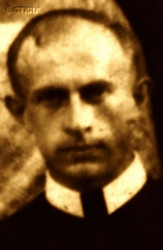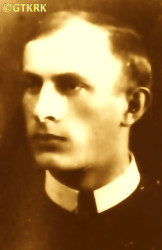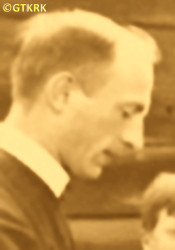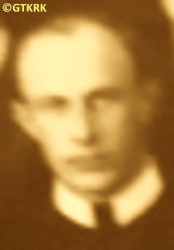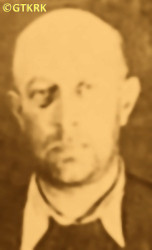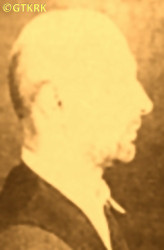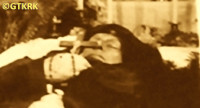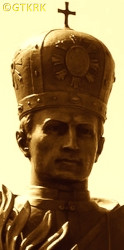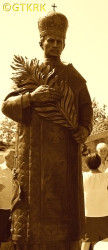Roman Catholic
St Sigismund parish
05-507 Słomczyn
85 Wiślana Str.
Konstancin deanery
Warsaw archdiocese, Poland
full list:
displayClick to display full list

searchClick to search full list by categories
wyświetlKliknij by wyświetlić pełną listę po polsku

szukajKliknij by przeszukać listę wg kategorii po polsku

Martyrology of the clergy — Poland
XX century (1914 – 1989)
personal data
surname
BAŁAHURAK
forename(s)
Vladimir (pl. Włodzimierz)
religious forename(s)
Gregory (pl. Grzegorz)
function
bishop
creed
Ukrainian Greek Catholic GCmore on
en.wikipedia.org
[access: 2013.05.19]
congregation
Basilian Order of Saint Josaphat OSBMmore on
en.wikipedia.org
[access: 2014.09.21]
(i.e. Basilians)
diocese / province
Stanyslaviv GC eparchymore on
en.wikipedia.org
[access: 2013.05.19]
nationality
Ukrainian
date and place
of death
02.10.1965

Korkinotoday: Korkino reg., Chelyabinsk oblast, Russia
more on
en.wikipedia.org
[access: 2022.08.05]
details of death
After German and Russian invasion of Poland in 09.1939 and start of the World War II, after German defeat and start in 1944 of another Russian occupation, secretly ordained as bishop in 04.1945 by Bp Gregory Chomyszyn — who faced imminent arrest (that in fact took place on 15.04.1945).
After formal dissolution of the Greek Catholic Church by the Russians in 1946 and its incorporation into Orthodox Church lived secretly? in Stanislaviv and nearby Pogonya village where Holy Mary Assumption into Heaven monastery is located (till 1948).
Next worked as a mechanic in Stanislaviv.
There, straight from a street, arrested by the Russians on 13/15.10.1949.
Accused of „being hostile to the Russian authorities, leading Greek Catholic opposition, conducting anti–Russian activities, fostering religious prejudices of citizens, organising criminal relations with the states hostile to Russia”.
On 11.10.1950 sentenced to 10 years of slave labour in Russian slave labour concentration camps Gulag.
Transported to ITL KarLag camp, No. 9 in Dolinka village in Kazakhstan.
Released on 31.05.1956.
Returned to Stanislaviv.
In 1957 evicted from there by the Russians (or arrested again).
Went into exile, to Rosa village near Korkino town, c. 40 km from oblast's capital Chelabinsk.
There slaved at furniture factory and there perished — while manning a wood machine, prob. „from heart attack”.
The body was brought back to Stanislaviv, where was buried.
cause of death
extermination
perpetrators
Russians
sites and events
Forced exileClick to display the description, ITL KarLagClick to display the description, GulagClick to display the description, Ribbentrop‐MolotovClick to display the description, Pius XI's encyclicalsClick to display the description
date and place
of birth
05.07.1909

Stanislavivtoday: Ivano‐Frankivsk, Stanislaviv/Ivano‐Frankivsk rai., Stanislaviv/Ivano‐Frankivsk obl., Ukraine
more on
en.wikipedia.org
[access: 2020.11.20]
parents
BAŁAHURAK Elias
🞲 ?, ? — 🕆 ?, ?

Caroline
🞲 ?, ? — 🕆 ?, ?
religious vows
01.05.1927 (temporary)
16.12.1934 (permanent)
presbyter (holy orders)
ordination
21.05.1936

Zhovkvatoday: Zhovkva urban hrom., Lviv rai., Lviv obl., Ukraine
more on
en.wikipedia.org
[access: 2020.11.22]
positions held
1945 – 1965
auxiliary bishop (Lat. episcopus auxiliaris) — Stanislaviv GK eparchy — ordination: on 04.1945
1941 – 1945
prior — Stanislavivtoday: Ivano‐Frankivsk, Stanislaviv/Ivano‐Frankivsk rai., Stanislaviv/Ivano‐Frankivsk obl., Ukraine
more on
en.wikipedia.org
[access: 2020.11.20] ⋄ Basilians OSBM ⋄ GC monastery
1938 – 1941
monk — Krystynopiltoday: Sheptytskyi, Sheptytskyi urban hrom., Sheptytskyi rai., Lviv obl., Ukraine
more on
en.wikipedia.org
[access: 2022.08.05] ⋄ Basilians OSBM ⋄ St George GC monastery — also: administrator of various parishes
1936 – 1938
monk — Stanislavivtoday: Ivano‐Frankivsk, Stanislaviv/Ivano‐Frankivsk rai., Stanislaviv/Ivano‐Frankivsk obl., Ukraine
more on
en.wikipedia.org
[access: 2020.11.20] ⋄ Basilians OSBM ⋄ GC monastery — also: parish administrator
1935 – 1936
student — Zhovkvatoday: Zhovkva urban hrom., Lviv rai., Lviv obl., Ukraine
more on
en.wikipedia.org
[access: 2020.11.22] ⋄ philosophy and theology, Basilians OSBM ⋄ Nativity of Christ GC monastery
1933 – 1935
student — Krystynopiltoday: Sheptytskyi, Sheptytskyi urban hrom., Sheptytskyi rai., Lviv obl., Ukraine
more on
en.wikipedia.org
[access: 2022.08.05] ⋄ Theological Study, Basilians OSBM ⋄ St George GC monastery
1933
monk — Buchachtoday: Buchach urban hrom., Chortkiv rai., Ternopil obl., Ukraine
more on
en.wikipedia.org
[access: 2020.11.15] ⋄ Basilians OSBM ⋄ Exaltation of the Lord's Cross GC monastery — also: Ukrainian, German, Latin, Greek, singing and music teacher at the Mission Institute
1930 – 1932
monk — Dobromyltoday: Dobromyl urban hrom., Sambir rai., Lviv obl., Ukraine
more on
en.wikipedia.org
[access: 2021.10.09] ⋄ Basilians OSBM ⋄ St Onuphrius GC monastery
1927 – 1930
monk — Lavrivtoday: Staryi Sambir urban hrom., Sambir rai., Lviv obl., Ukraine
more on
en.wikipedia.org
[access: 2022.08.06] ⋄ Basilians OSBM ⋄ St Onuphrius GC monastery
1925 – 1927
novitiate — Krekhivtoday: Zhovkva urban hrom., Lviv rai., Lviv obl., Ukraine
more on
en.wikipedia.org
[access: 2022.08.06] ⋄ St Nicholas GC monastery, Basilians OSBM
from 06.09.1925
monk — Basilians OSBM
others related
in death
CHOMYSZYNClick to display biography Gregory, ŁUKACZClick to display biography Simon
sites and events
descriptions
Forced exile: One of the standard Russian forms of repression. The prisoners were usually taken to a small village in the middle of nowhere — somewhere in Siberia, in far north or far east — dropped out of the train carriage or a cart, left out without means of subsistence or place to live. (more on: en.wikipedia.orgClick to attempt to display webpage
[access: 2014.12.20])
ITL KarLag: Russian Rus. Исправи́тельно‐Трудово́й Ла́герь (Eng. Corrective Labor Camp) ITL Rus. Карагандинский (Eng. Karagandskiy) — concentration and slave forced labor camp (within the Gulag complex) — with headquarters in the city of Karaganda, Karaganda Oblast in Kazakhstan. Founded on 17.09.1931. One of the largest in the Gulag complex. It covered an area of 300 by 200 km, with its center in the Dolynka village, c. 45 km from Karaganda. One of the tasks was to grow food, especially animal husbandry, for the emerging centers of coal mining and heavy industry in Kazakhstan. Prisoners slaved in camp workshops (metal processing, drawing, tailoring), in the production of construction materials, in a glassworks, a sugar refinery, a vegetable drying plant, in coal mines, limestone mining, and in fishing. At its peak, c. 65,000 prisoners were held there: e.g. 45,798 (01.01.1943); 50,080 (01.01.1944); 53,946 (01.01.1945); 60,745 (01.01.1947); 63,555 (01.01.1948); 65,673 (01.01.1949); 54,179 (01.01.1950); 45,675 (01.01.1951). In total, c. 1,000,000 people passed through the camp, including many women and children. Many died. It ceased operations on 27.07.1959. (more on: en.wikipedia.orgClick to attempt to display webpage
[access: 2019.10.13])
Gulag: The acronym Gulag comes from the Rus. Главное управление исправительно‐трудовых лагерей и колоний (Eng. Main Board of Correctional Labor Camps). The network of Russian concentration camps for slave labor was formally established by the decision of the highest Russian authorities on 27.06.1929. Control was taken over by the OGPU, the predecessor of the genocidal NKVD (from 1934) and the MGB (from 1946). Individual gulags (camps) were often established in remote, sparsely populated areas, where industrial or transport facilities important for the Russian state were built. They were modeled on the first „great construction of communism”, the White Sea‐Baltic Canal (1931‐1932), and Naftali Frenkel, of Jewish origin, is considered the creator of the system of using forced slave labor within the Gulag. He went down in history as the author of the principle „We have to squeeze everything out of the prisoner in the first three months — then nothing is there for us”. He was to be the creator, according to Alexander Solzhenitsyn, of the so‐called „Boiler system”, i.e. the dependence of food rations on working out a certain percentage of the norm. The term ZEK — prisoner — i.e. Rus. заключенный‐каналоармец (Eng. canal soldier) — was coined in the ITL BelBaltLag managed by him, and was adopted to mean a prisoner in Russian slave labor camps. Up to 12 mln prisoners were held in Gulag camps at one time, i.e. c. 5% of Russia's population. In his book „The Gulag Archipelago”, Solzhenitsyn estimated that c. 60 mln people were killed in the Gulag until 1956. Formally dissolved on 20.01.1960. (more on: en.wikipedia.orgClick to attempt to display webpage
[access: 2024.04.08])
Ribbentrop‐Molotov: Genocidal Russian‐German alliance pact between Russian leader Joseph Stalin and German leader Adolf Hitler signed on 23.08.1939 in Moscow by respective foreign ministers, Mr. Vyacheslav Molotov for Russia and Joachim von Ribbentrop for Germany. The pact sanctioned and was the direct cause of joint Russian and German invasion of Poland and the outbreak of the World War II in 09.1939. In a political sense, the pact was an attempt to restore the status quo ante before 1914, with one exception, namely the „commercial” exchange of the so‐called „Kingdom of Poland”, which in 1914 was part of the Russian Empire, fore Eastern Galicia (today's western Ukraine), in 1914 belonging to the Austro‐Hungarian Empire. Galicia, including Lviv, was to be taken over by the Russians, the „Kingdom of Poland” — under the name of the General Governorate — Germany. The resultant „war was one of the greatest calamities and dramas of humanity in history, for two atheistic and anti‐Christian ideologies — national and international socialism — rejected God and His fifth Decalogue commandment: Thou shall not kill!” (Abp Stanislav Gądecki, 01.09.2019). The decisions taken — backed up by the betrayal of the formal allies of Poland, France and Germany, which on 12.09.1939, at a joint conference in Abbeville, decided not to provide aid to attacked Poland and not to take military action against Germany (a clear breach of treaty obligations with Poland) — were on 28.09.1939 slightly altered and made more precise when a treaty on „German‐Russian boundaries and friendship” was agreed by the same murderous signatories. One of its findings was establishment of spheres of influence in Central and Eastern Europe and in consequence IV partition of Poland. In one of its secret annexes agreed, that: „the Signatories will not tolerate on its respective territories any Polish propaganda that affects the territory of the other Side. On their respective territories they will suppress all such propaganda and inform each other of the measures taken to accomplish it”. The agreements resulted in a series of meeting between two genocidal organization representing both sides — German Gestapo and Russian NKVD when coordination of efforts to exterminate Polish intelligentsia and Polish leading classes (in Germany called «Intelligenzaktion», in Russia took the form of Katyń massacres) where discussed. Resulted in deaths of hundreds of thousands of Polish intelligentsia, including thousands of priests presented here, and tens of millions of ordinary people,. The results of this Russian‐German pact lasted till 1989 and are still in evidence even today. (more on: en.wikipedia.orgClick to attempt to display webpage
[access: 2015.09.30])
Pius XI's encyclicals: Facing the creation of two totalitarian systems in Europe, which seemed to compete with each other, though there were more similarities than contradictions between them, Pope Pius XI issued in 03.1937 (within 5 days) two encyclicals. In the „Mit brennender Sorge” (Eng. „With Burning Concern”) published on 14.03.1938, condemned the national socialism prevailing in Germany. The Pope wrote: „Whoever, following the old Germanic‐pre‐Christian beliefs, puts various impersonal fate in the place of a personal God, denies the wisdom of God and Providence […], whoever exalts earthly values: race or nation, or state, or state system, representatives of state power or other fundamental values of human society, […] and makes them the highest standard of all values, including religious ones, and idolizes them, this one […] is far from true faith in God and from a worldview corresponding to such faith”. On 19.03.1937, published „Divini Redemptoris” (Eng. „Divine Redeemer”), in which criticized Russian communism, dialectical materialism and the class struggle theory. The Pope wrote: „Communism deprives man of freedom, and therefore the spiritual basis of all life norms. It deprives the human person of all his dignity and any moral support with which he could resist the onslaught of blind passions […] This is the new gospel that Bolshevik and godless communism preaches as a message of salvation and redemption of humanity”… Pius XI demanded that the established human law be subjected to the natural law of God , recommended the implementation of the ideal of a Christian state and society, and called on Catholics to resist. Two years later, National Socialist Germany and Communist Russia came together and started World War II. (more on: www.vatican.vaClick to attempt to display webpage
[access: 2023.05.28], www.vatican.vaClick to attempt to display webpage
[access: 2023.05.28])
sources
personal:
www.catholic-hierarchy.orgClick to attempt to display webpage
[access: 2021.12.19], gk.if.uaClick to attempt to display webpage
[access: 2015.03.01], risu.org.uaClick to attempt to display webpage
[access: 2019.12.29], en.wikipedia.orgClick to attempt to display webpage
[access: 2019.12.29]
original images:
gk.if.uaClick to attempt to display webpage
[access: 2015.03.01], uk.wikipedia.orgClick to attempt to display webpage
[access: 2019.12.29], risu.org.uaClick to attempt to display webpage
[access: 2019.12.29], risu.org.uaClick to attempt to display webpage
[access: 2019.12.29], risu.org.uaClick to attempt to display webpage
[access: 2019.12.29], risu.org.uaClick to attempt to display webpage
[access: 2019.12.29], risu.org.uaClick to attempt to display webpage
[access: 2019.12.29], firtka.if.uaClick to attempt to display webpage
[access: 2019.12.29], firtka.if.uaClick to attempt to display webpage
[access: 2019.12.29]
LETTER to CUSTODIAN/ADMINISTRATOR
If you have an Email client on your communicator/computer — such as Mozilla Thunderbird, Windows Mail or Microsoft Outlook, described at WikipediaPatrz:
en.wikipedia.org, among others — try the link below, please:
LETTER to CUSTODIAN/ADMINISTRATORClick and try to call your own Email client
If however you do not run such a client or the above link is not active please send an email to the Custodian/Administrator using your account — in your customary email/correspondence engine — at the following address:

giving the following as the subject:
MARTYROLOGY: BAŁAHURAK Vladimir
To return to the biography press below:
 Click to return to biography
Click to return to biography








